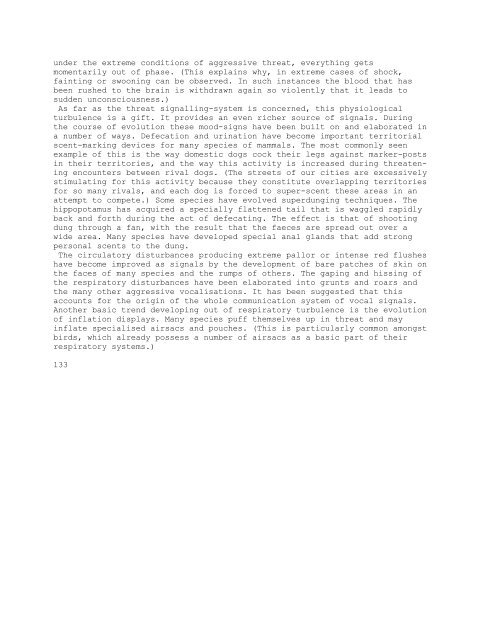Create successful ePaper yourself
Turn your PDF publications into a flip-book with our unique Google optimized e-Paper software.
under the extreme conditions of aggressive threat, everything gets<br />
momentarily out of phase. (This explains why, in extreme cases of shock,<br />
fainting or swooning can be observed. In such instances the blood that has<br />
been rushed to the brain is withdrawn again so violently that it leads to<br />
sudden unconsciousness.)<br />
As far as the threat signalling-system is concerned, this physiological<br />
turbulence is a gift. It provides an even richer source of signals. During<br />
the course of evolution these mood-signs have been built on and elaborated in<br />
a number of ways. Defecation and urination have become important territorial<br />
scent-marking devices for many species of mammals. The most commonly seen<br />
example of this is the way domestic dogs cock their legs against marker-posts<br />
in their territories, and the way this activity is increased during threatening<br />
encounters between rival dogs. (The streets of our cities are excessively<br />
stimulating for this activity because they constitute overlapping territories<br />
for so many rivals, and each dog is forced to super-scent these areas in an<br />
attempt to compete.) Some species have evolved superdunging techniques. The<br />
hippopotamus has acquired a specially flattened tail that is waggled rapidly<br />
back and forth during the act of defecating. The effect is that of shooting<br />
dung through a fan, with the result that the faeces are spread out over a<br />
wide area. Many species have developed special anal glands that add strong<br />
personal scents to the dung.<br />
The circulatory disturbances producing extreme pallor or intense red flushes<br />
have become improved as signals by the development of bare patches of skin on<br />
the faces of many species and the rumps of others. The gaping and hissing of<br />
the respiratory disturbances have been elaborated into grunts and roars and<br />
the many other aggressive vocalisations. It has been suggested that this<br />
accounts for the origin of the whole communication system of vocal signals.<br />
Another basic trend developing out of respiratory turbulence is the evolution<br />
of inflation displays. Many species puff themselves up in threat and may<br />
inflate specialised airsacs and pouches. (This is particularly common amongst<br />
birds, which already possess a number of airsacs as a basic part of their<br />
respiratory systems.)<br />
133








